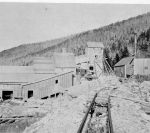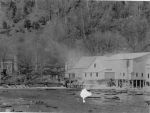Steatite
The discovery of Steatite, a hardened form of talc and commonly known as soapstone because of its smooth, soap-like quality, brought about, in 1865, the Rochester Soapstone Company. Steatite was valued for its heat-keeping properties, especially for stoves and foot warmers. When the harder soapstone deposit led into the softer form of talc, Steatite mining was abandoned, and in its place a succession of talc companies mined the talc deposits remaining on the site, with talc blocks being drawn down the mountain to be ground into powder at a mill on the White River, and subsequently shipped out of the area on the White River Valley Railroad. The Great 1927 Flood ended the talc industry in Rochester.













